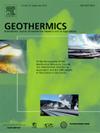热导率测量的可靠性和可变性:日本CIT-TRT和传统TRT的比较
IF 3.5
2区 工程技术
Q3 ENERGY & FUELS
引用次数: 0
摘要
本研究利用恒定入口温度热响应测试(CIT-TRT)的数据,评估了反热交换率(1/q')方法估算地面导热系数的有效性。采用恒热负荷TRT(常规)和CIT-TRT等7种TRT方法,在日本两个不同地点进行了试验,并与传统TRT的Horner图法和对数法进行了比较。研究结果表明,使用该方法估计的热导率与使用Horner图方法确定的热导率仅相差3.5%,证实了该方法的适用性。此外,将CIT-TRT结果与常规TRT结果进行了比较,验证了1/q’方法的有效性。此外,CIT-TRT在25°C和35°C两种不同的进口温度下进行,以评估该方法在有限热负荷条件下的有效性。结果表明,较低的入口温度产生了可接受的结果,尽管它只比该地区的初始地温高5°C。作为本研究的主要成果,1/q '方法为cit - trt的导热系数估计提供了一种实用而有效的方法,显著减少了计算时间,同时在不同的进口温度、GHE配置(单u管或双u管)和不同的地质条件下保持准确性。本文章由计算机程序翻译,如有差异,请以英文原文为准。
Reliability and variability in thermal conductivity measurements: A comparison of CIT-TRT and conventional TRT in Japan
This study evaluates the effectiveness of the inverse heat exchange rate (1/q') method for estimating thermal conductivity of the ground using data from the constant inlet temperature thermal response test (CIT-TRT). In total seven TRTs including constant heat load TRT (conventional) and CIT-TRT were conducted in two different locations in Japan to compare the results of this method with those obtained from the Horner plot method and logarithmic graphical method for the conventional TRTs. The findings indicated that the estimated thermal conductivities using this method deviated by only 3.5% from those determined using the Horner plot method, confirming the applicability of this approach. In addition, the results from the CIT-TRT were compared with those obtained from the conventional TRT, which demonstrated the validity of the 1/q' method. Furthermore, the CIT-TRT was performed using two different inlet temperatures, 25°C and 35°C, to evaluate the effectiveness of this method under conditions with a limited heat load power. The results showed that the lower inlet temperature produced acceptable outcomes, though it was only 5°C above the initial ground temperature in the region. As the main achievement of this research, the 1/q′ method is shown to offer a practical and efficient approach for thermal conductivity estimation in CIT-TRTs, significantly reducing computational time while maintaining accuracy across varying inlet temperatures, GHE configurations (single or double U-tubes), and diverse geological conditions.
求助全文
通过发布文献求助,成功后即可免费获取论文全文。
去求助
来源期刊

Geothermics
工程技术-地球科学综合
CiteScore
7.70
自引率
15.40%
发文量
237
审稿时长
4.5 months
期刊介绍:
Geothermics is an international journal devoted to the research and development of geothermal energy. The International Board of Editors of Geothermics, which comprises specialists in the various aspects of geothermal resources, exploration and development, guarantees the balanced, comprehensive view of scientific and technological developments in this promising energy field.
It promulgates the state of the art and science of geothermal energy, its exploration and exploitation through a regular exchange of information from all parts of the world. The journal publishes articles dealing with the theory, exploration techniques and all aspects of the utilization of geothermal resources. Geothermics serves as the scientific house, or exchange medium, through which the growing community of geothermal specialists can provide and receive information.
 求助内容:
求助内容: 应助结果提醒方式:
应助结果提醒方式:


